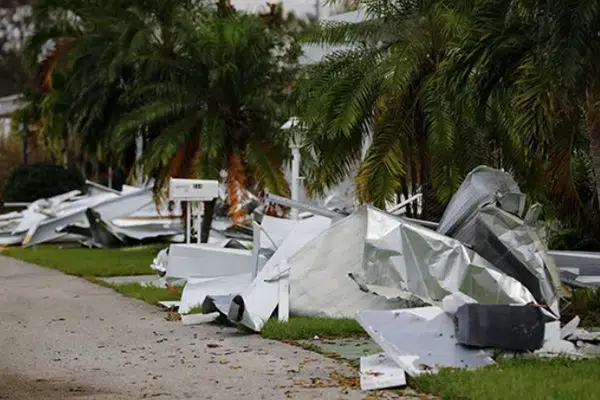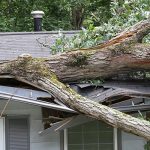Although Florida is known as the “Sunshine State,” it is also infamous for the storms that whip through the state during hurricane season. Florida’s homeowners know firsthand that damage caused by powerful winds during a storm can be extensive even without a hurricane.
What Kinds of Damaging Winds Occur in Florida?
When you contemplate the possibility of wind damage to your property, you likely focus on winds that accompany a hurricane or tropical storm. While hurricanes and tropical storms do frequently produce damaging winds, other types of winds may also result in property damage. According to the National Severe Storms, the following types of winds also occur in Florida:
- Straight-line wind. This involves wind caused by a thunderstorm that does not include rotation (tornado-like) winds.
- Downdraft. The wind caused by a small-scale column of air that rapidly sinks toward the ground.
- Macroburst. A microburst is an outward burst of strong winds that occurs when a strong downdraft within a thunderstorm reaches the surface. These winds usually occur in conjunction with thunderstorms, but can also occur with weaker rainstorms, and typically cause widespread damage similar to that of a tornado.
- Microburst. Usually associated with thunderstorms, a microburst is a small, short-lived strong wind event that produces an outward burst of strong winds (up to 100 mph) at or near the surface.
- Gust front. These winds usually occur before a thunderstorm with a wind shift and drop in temperature when the air cooled by rain hits the warmer flow of storm air.
- Derecho. A derecho is a long-lasting windstorm that covers more than 240 miles and is associated with a band of rapidly moving showers or thunderstorms.
What Kind of Damage Does Wind Cause in Florida?
Although technological advances have allowed for improved weather forecasting, damaging winds (classified as those greater than 50 – 60 mph) are still difficult to predict given that any type of rainstorm can produce them. Moreover, a variety of different meteorological processes can result in damaging winds. The National Severe Storms Laboratory reports that thunderstorm winds can be very severe and may include speeds up to 100 mph that extend for hundreds of miles.
For homeowners, the inability to accurately predict potentially damaging winds can be worrisome. The Beaufort chart, originally developed by Britain’s Admiral Sir Francis Beaufort in 1805, is still used by the National Weather Service to estimate wind speeds and their corresponding effects. According to the Beaufort scale, damaging winds are those that are classified as numbers 9 through 12:
- Beaufort Number 9 — Strong Gale: With 47 to 54 mph winds, structural property damage occurs, including chimney covers, roofing shingles or tiles, and antennas. Tree branches break off and can also cause damage.
- Beaufort Number 10 — Whole Gale: With 55 to 63 mph winds, a lot of structural damage occurs, especially to roofs. In addition to branches breaking off trees, small trees can be blown over or uprooted.
- Beaufort Number 11 — Storm Force: With winds between 64 and 75 mph, widespread structural damage occurs, and larger trees can be blown over and uprooted.
- Beaufort Number 12 — Hurricane Force: With winds more than 75 mph, severe and extensive damage occurs to roofs, windows, automobiles, RVs, mobile homes, and trees.
Do I Need a Florida Wind Damage Insurance Claim Attorney?
The Atlantic Hurricane Season officially begins the first of June and runs through the end of October. During that period, Florida property is especially vulnerable to damage from powerful winds, even if those winds are not part of a full-blown hurricane. From a roof being blown off to cars being blown over, the damage to your property can be extensive and expensive to repair. If you do experience wind damage to your property, you expect your homeowner’s insurance company to repair the damage or compensate you for your loss without delay.
If you filed a wind damage claim that has been denied or unreasonably delayed, you should consult with an experienced Florida wind damage claims attorney. An attorney can investigate the damage, review your insurance policy, and evaluate the cause of the denial or delay. Ideally, your attorney will negotiate a full and fair settlement for you; however, if a settlement is not possible, your wind damage claim attorney will aggressively litigate your claim to ensure that you are fairly and fully compensated.
Will I Need to File a Lawsuit?
Property owners are often worried that they will need to go to court if they challenge their insurance company. The good news is that most wind damage claims do not require litigation; however, if litigation does become necessary, having an experienced attorney on your side will be the key to ensuring that your rights are protected and that you are compensated for your damage or loss.
How Much Will a Florida Wind Damage Attorney Cost?
You may also be reluctant to contact an attorney because you are concerned that you do not have the money for an attorney. Typically, however, an experienced wind damage claims attorney will not charge you anything upfront. Your attorney will only be paid if you accept a settlement or are awarded a verdict at trial.
Where Can I Get Help with My Florida Wind Damage Claim?
If you are a Florida homeowner who needs to file a homeowner’s insurance claim or has already filed a denied or delayed claim, an experienced insurance attorney can help. Call us at 407-500-1000 or submit our online form today. One of our experienced Florida homeowner’s insurance claim attorneys will explain your rights to you in more detail and discuss your legal options at no cost.




